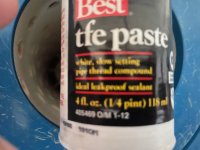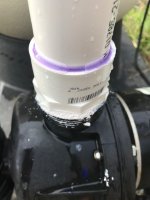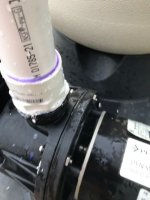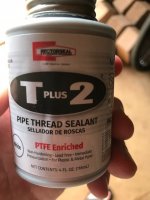Hi,
I had my pump strainer basket broke so I replaced it and did the plumbing job myself to repair the plumbing and add in unions so it would be easier to repair in the future. I did a pretty shoddy job, but it lasted through this past summer thanks to Flex Seal (lol, I know)
The Flex Seal is starting to fail this summer and it’s leaking pretty bad now and air is getting to my lines and the flow light is red on my SWG so it’s not producing chlorine…
It’s really leaking in two areas, where the plumbing adapter threads into my Pentair 340400 pump and at the vertical union in the O-ring. See the pics below:
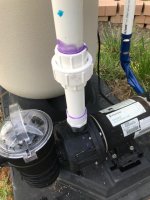
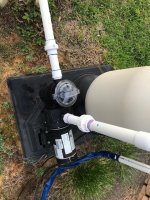
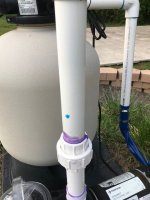
The big leak is at the threaded adapter. I used Teflon tape both times trying to repair this and it's still leaking. Is there any other product that I could use to seal it? When I first unscrewed it from when it was installed, there was some "playdoh" like material, but I am not sure what that is to buy it again...
Not sure why the union is leaking either, the two sides of the union are pretty tight together and I screwed it down tight.
Thanks for the help!
Aaron
I had my pump strainer basket broke so I replaced it and did the plumbing job myself to repair the plumbing and add in unions so it would be easier to repair in the future. I did a pretty shoddy job, but it lasted through this past summer thanks to Flex Seal (lol, I know)
The Flex Seal is starting to fail this summer and it’s leaking pretty bad now and air is getting to my lines and the flow light is red on my SWG so it’s not producing chlorine…
It’s really leaking in two areas, where the plumbing adapter threads into my Pentair 340400 pump and at the vertical union in the O-ring. See the pics below:



The big leak is at the threaded adapter. I used Teflon tape both times trying to repair this and it's still leaking. Is there any other product that I could use to seal it? When I first unscrewed it from when it was installed, there was some "playdoh" like material, but I am not sure what that is to buy it again...
Not sure why the union is leaking either, the two sides of the union are pretty tight together and I screwed it down tight.
Thanks for the help!
Aaron
Last edited:


